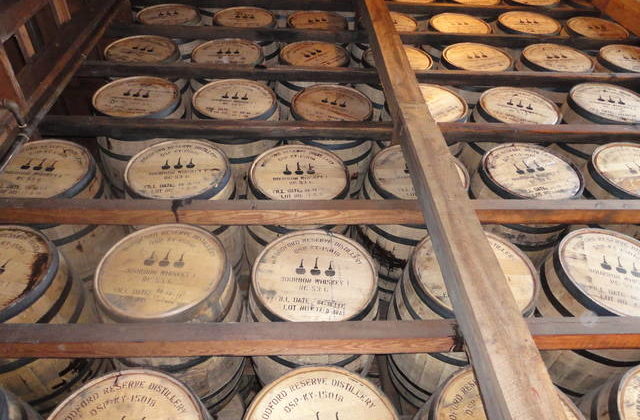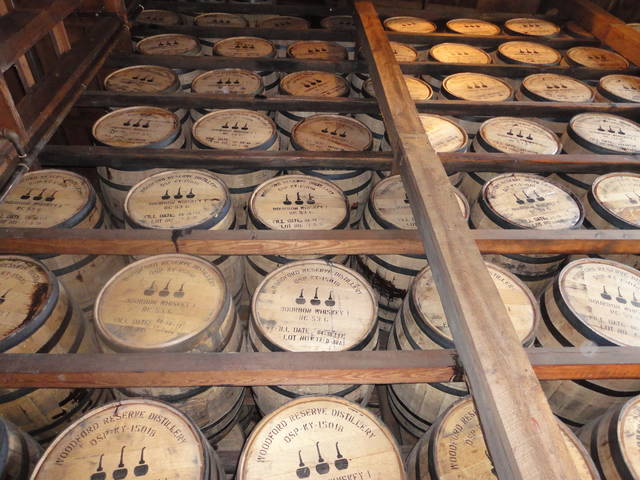
Story and photos by Jane Beathard

It’s the all-American alcoholic beverage.
And 95 percent of the world’s bourbon whiskey is produced in central Kentucky — all within a two-hour drive from most points in southern Ohio.
That fact and many more about the Bluegrass State’s history and culture are awaiting discovery on the Kentucky Bourbon Trail.
About a million visitors travel the trail annually, said Sam Newton of the Bourbon Trail Visitors Center in Louisville’s Frazier History Museum.
The center encapsulates the history of bourbon and why the very best comes out of Kentucky.
In 1999, the Kentucky Distillers’ Association created the trail to increase its members’ revenues and spur interest in the liquor.
There are currently 17 distilleries (stops) on the formal trail, with 20 on a special Craft Bourbon Trail.
Newton said it takes about nine days to experience them all on a self-guided tour — at a rate of about two distilleries a day.
For anyone who doesn’t have that kind of time, he recommends three tour companies — Copper Stills, Central Kentucky Tours and Mint Julep Experiences.
Staff do the driving — not a bad idea since tastings conclude each stop. And knowledgeable guides describe just how and why Kentucky came to be the bourbon capital of the universe.
Mint Julep was the first to organize a formal tour in 2008. Today, the company has 26 vehicles of various capacities and conducts tours Wednesday through Sunday.
Guide Joni has been with the company since day one.
“Bourbon took off in 2010 and then accelerated two years ago,” she explained. “The market has doubled in recent years.”
Joni credits TV shows like “Mad Men” for making bourbon fashionable after years of indifference.
Then, there’s the overseas market that is soaring — especially in Asia. Several big Kentucky distilleries are now Japanese owned.
“It’s also now fashionable for women,” Joni said. “And Mint Julep offers ‘women only’ tours.”
Each distiller employs a somewhat unique process, but all are very interesting, she explained.
Mint Julep’s “east” tour takes visitors into Kentucky’s horse country; while the “south” tour goes into the state’s old tobacco-growing area.
Some distillers like Heaven Hill jumped on the tour bandwagon early. Its production facility is geared to show visitors a good time as well as whiskey making. Others like Old Forester, Evan Williams and Makers Mark soon followed.
Roots of the bourbon tradition run deep in Kentucky soil and can be traced to France and the American Revolution. Louisville is named for King Louis XVI who assisted the American cause during that war. He was of the House of Bourbon and when Kentucky joined the union in 1792, what was then the eastern half of the state was named in his honor.
Irish and German immigrants had brought their liquor-making skills to the new country. They were mostly East Coast dwellers and learned to mix yeast with the more plentiful corn (instead of rye) to create a unique spirit.
When the fledgling U.S. government enacted a Whiskey Tax in 1791 to pay off the war debt, many of these early distillers fled to Kentucky’s frontier to escape the “revenuers.”
The state’s limestone-based spring water gave a distinctive taste to the clear “moonshine” these liquor pioneers developed. The same water also made area grasses slightly blue-green in color. Hence Kentucky became the Bluegrass State.
Legend has it that a Baptist minister named Elijah Craig stored his clear moonshine in a charred barrel following a barn fire. That barrel eventually produced a whiskey that was brown and so tasty that others began to mimic the process. The longer the moonshine was stored in the charred barrel, the more flavorful it got.
“(Craig) accidentally created bourbon (as we know it),” Joni said.
Bourbon had a good run until the early 1900s when the temperance movement and infamous Volstead Act put a damper on Kentucky’s flourishing liquor industry.
From 1920 to 1933, when the act was repealed, only a handful of distillers were allowed to produce bourbon for “medicinal purposes.” One of those was Buffalo Trace, now the oldest continuously operating distillery in the country and an important stop on the trail.
To make sure products were safe and drinkable (bottled in bond), in 1964 the federal government set production, content and storage standards for bourbon.
First and foremost, it must be produced in the U.S., although not necessarily in Kentucky.
Fifty-one percent of the grain used to make straight bourbon must be corn, with the rest barley, rye or wheat. It must be aged at least two years in new, charred, white oak barrels.
Its strength usually runs between 80 and 125 proof, with the legal minimum bottled strength being 80 proof or 40 percent alcohol. Only limestone-filtered spring water may be used to lower alcohol content.
“Blended” bourbon must contain at least 51 percent straight bourbon.
Today, bourbon is a $8.6 billion industry in Kentucky and more than 20,000 people are employed in its creation and distribution. On any given day, there are 8 million barrels aging in the state’s “rickhouses” (bourbon warehouses), Joni said.
Distilleries both big and little are scrambling to keep up with demand and scores of new rickhouses dot the landscape.
“Bourbon is on the upswing,” Joni noted. “It has exploded.”
___
Bourbon by the numbers
• A bourbon rickhouse or warehouse can contain up to 20,000 barrels at one time.
• Jim Beam produces a third of all bourbon distilled in Kentucky.
• Kentucky’s traditional Bourbon Trail includes 17 stops.
• By law, all bourbon must be derived from 51 percent corn.
___
Plan your getaway:
ID, 'source', true); $sourcelink = get_post_meta($post->ID, 'sourcelink', true); $sourcestring = '' . __('SOURCE','gabfire') . ''; if ($sourcelink != '') { echo "
$sourcestring: $source
"; } elseif ($source != '') { echo "$sourcestring: $source
"; } // Display pagination $args = array( 'before' => '' . __('Pages:','gabfire'), 'after' => '
', 'link_before' => '', 'link_after' => '', 'next_or_number' => 'number', 'nextpagelink' => __('Next page', 'gabfire'), 'previouspagelink' => __('Previous page', 'gabfire'), 'pagelink' => '%', 'echo' => 1 ); wp_link_pages($args); // Display edit post link to site admin edit_post_link(__('Edit','gabfire'),'','
'); // Post Widget gab_dynamic_sidebar('PostWidget'); ?>